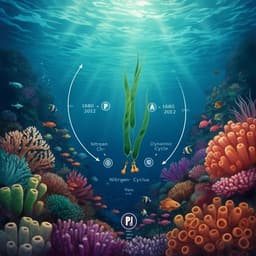
Earth Sciences
Highest ocean heat in four centuries places Great Barrier Reef in danger
B. J. Henley, H. V. Mcgregor, et al.
The Great Barrier Reef is facing unprecedented challenges from anthropogenic climate change, with the warmest Coral Sea heat extremes recorded in 400 years leading to severe coral bleaching. This urgent research conducted by Benjamin J. Henley, Helen V. McGregor, and others underscores the need for immediate action to protect this vital ecosystem.
~3 min • Beginner • English
Introduction
The Great Barrier Reef (GBR) has experienced increasingly frequent and severe mass coral bleaching events in recent decades, linked to elevated sea surface temperatures (SSTs). Although instrumental records document recent warming, the long-term context of these temperatures relative to past centuries has been unclear. Previous indications of bleaching exist from the 1980s onward, with potential evidence during the 1877–78 El Niño from coral stress bands, but severe mass bleaching appears absent for most of the 1800s and 1900s. El Niño events and local factors (cloud cover, irradiance) have contributed to heat stress, while recent events (2016–2017, 2020, 2022, 2024) have affected large portions of the GBR, causing extensive mortality in shallow-water corals. This study aims to place recent Coral Sea and GBR January–March SST extremes within a multi-century (400-year) context and assess the extent to which anthropogenic climate change has driven recent warming and associated bleaching risk.
Literature Review
The paper reviews evidence that mass coral bleaching on the GBR was first documented in the 1980s and has intensified with ocean warming. Coral skeletal stress bands suggest possible pre-1980 bleaching (for example, 1877–78 El Niño), but few cores before 1960 show such signals, implying severe mass bleaching was uncommon in earlier centuries. Prior multi-century reconstructions from central GBR coral cores (inner and outer shelf, including Flinders Reef) suggested early 2000s SSTs were not unprecedented relative to the last three centuries; however, those records had coarse five-year resolution and ended in the early 2000s, limiting interpretation of recent warming. El Niño events in 1998 and 2002 elevated SSTs and bleaching risk, with other local factors (cloud cover, irradiance) modulating stress. Subsequent updates to coral records improved temporal resolution but remained spatially limited, motivating a broader network-based reconstruction to contextualize recent extremes.
Methodology
- Compiled a network of 22 coral geochemical paleothermometer series (Sr/Ca and δ18O) from sites in and near the Coral Sea region to reconstruct January–March SSTs back to 1618.
- Calibrated reconstructions primarily to ERSSTv5 instrumental SSTs (also compared/calibrated to HadISST1.1) to extend the instrumental record and quantify multi-decadal to centennial variability.
- Assessed correlation between January–March GBR-averaged SST anomalies (SSTAs) and Coral Sea SSTAs, both raw and detrended, to justify use of Coral Sea SSTAs as a proxy for GBR bleaching risk.
- Ranked combined reconstructed and instrumental January–March SSTAs for 1618–2024, incorporating reconstruction uncertainty to evaluate whether recent events exceed pre-1900 maxima at 90th–95th percentile thresholds.
- Conducted robustness checks, including network perturbation tests (incrementally varying included coral records by distance and correlation to target) and cross-validation with alternative coral datasets, to assess sensitivity of extreme-year rankings and reconstruction skill.
- Quantified warming trends using ERSSTv5 for 1900–2024 and 1960–2024; compared with results using HadISST1.1 to examine sensitivity to observational dataset choice.
- Performed detection and attribution analysis using CMIP6 DAMIP simulations, contrasting ‘historical’ (anthropogenic + natural forcings) with ‘historical-natural’ (natural forcings only) ensembles for the Coral Sea January–March SSTAs. Evaluated ensemble trends (1900–2014, 1950–2014, 1970–2014), used a bootstrap ensemble to assess trend significance, and compared observed recent SSTAs with model distributions.
- Estimated signal-to-noise ratio (SNR) emergence of the anthropogenic warming signal relative to natural variability over time.
- Examined five-year resolution GBR proxy series (central inshore and Flinders Reef outer shelf) aligned to modern observations to compare centennial trends and recent five-year means against pre-1900 maxima.
Key Findings
- The January–March Coral Sea heat extremes in 2024, 2017 and 2020 were the warmest in the past 400 years, exceeding the 95th-percentile uncertainty limit of the reconstructed pre-1900 maximum. The 2016, 2004 and 2022 events were also extreme, exceeding the 90th-percentile limit.
- Best-estimate reconstruction indicates January–March mean SST anomalies above the 1618–1899 average of: 2016 = 1.50 °C, 2017 = 1.54 °C, 2020 = 1.53 °C, 2022 = 1.46 °C, and 2024 = 1.73 °C.
- Observed ERSSTv5 shows strong warming trends: 0.09 °C per decade for 1900–2024 and 0.12 °C per decade for 1960–2024.
- January–March SSTAs averaged over the GBR are strongly correlated with Coral Sea SSTAs (ρ = 0.84, p < 0.01), remaining high after detrending (ρ = 0.69, p < 0.01), supporting use of Coral Sea anomalies as a bleaching risk indicator.
- The 2024 January–March season set a new Coral Sea record, exceeding the previous record by more than 0.19 °C (ERSSTv5).
- Ranking analysis for 1618–2024 shows the warmest three years (2024, 2017, 2020) surpass the 95th-percentile pre-1900 bound; 2016, 2004 and 2022 exceed the 90th-percentile bound. The warmest 23 January–March periods all occur after 1900, with the top 20 after 1950.
- Five-year resolution GBR proxy series show recent five-year mean January–March SSTAs narrowly exceed best-estimate pre-1900 maxima since the early 1600s; 14 five-year periods centered on 2012–2022 exceed the pre-1900 maximum by approximately 0.11 °C and 0.06 °C (inner and outer shelf records, respectively).
- CMIP6 DAMIP attribution: historical simulations show statistically significant warming trends (median) of about 0.05, 0.10 and 0.15 °C per decade for 1900–2014, 1950–2014 and 1970–2014, respectively; historical-natural trends are near zero (±0.01 °C per decade). In a bootstrap ensemble, 100% of historical runs show significant positive 1900–2014 trends, versus 0% for historical-natural.
- The observed mean Coral Sea January–March SSTA for 2016–2024 is 0.60 °C relative to 1961–90, warmer than any run in 79 historical-natural simulations from models with transient climate responses in the likely range.
- Emergence of anthropogenic signal: near zero in 1900, around 0.5 standard deviations by 1960, and exceeding 1.0 by 2017, indicating clear detection of human influence on Coral Sea January–March SSTs.
- The frequency and severity of recent GBR mass bleaching events align with these unprecedented thermal extremes and the anthropogenic warming trend, implying heightened ongoing bleaching risk.
Discussion
The study addresses the central question of whether recent GBR-related ocean heat extremes are unprecedented in a long-term context and the extent to which they are attributable to human influence. By combining a broad coral proxy network with instrumental datasets, the authors demonstrate that multiple recent January–March seasons (notably 2024, 2017 and 2020) exceed the reconstructed pre-1900 maxima with high confidence, firmly placing recent warming outside the range of natural variability over the past four centuries. Strong correlations between Coral Sea and GBR SST anomalies validate the use of Coral Sea conditions as a proxy for GBR bleaching risk and help explain the observed sequence of mass bleaching events since 2016. Detection and attribution analyses with CMIP6 DAMIP simulations show that anthropogenic forcing is necessary to explain the magnitude and trend of recent warming, with natural forcings alone unable to reproduce observed conditions. These findings underscore that the GBR is already experiencing realized impacts of climate change and faces elevated, possibly near-annual, bleaching risk without rapid mitigation and adaptation. While the Coral Sea–scale approach strengthens attribution, the discussion notes that coarse-resolution global models do not resolve all local oceanographic processes (currents, eddies, upwelling) that modulate site-specific conditions on the GBR, and additional high-resolution coral records from within the GBR would refine understanding of spatial variability and past event drivers.
Conclusion
This work provides a four-century context for Coral Sea and GBR January–March SSTs, showing that recent heat extremes—especially in 2024, 2017 and 2020—are unprecedented relative to pre-1900 variability. The combination of proxy reconstructions, instrumental observations and CMIP6 attribution analyses indicates that human-induced climate change is the primary driver of the observed rapid warming and the associated escalation in GBR bleaching risk. Without urgent emissions reductions and targeted interventions, the GBR is likely to experience continued frequent bleaching with adverse ecological and socio-economic consequences. Future research should expand high-resolution, temperature-sensitive coral proxy networks within the GBR, improve calibration datasets by addressing historical SST biases, refine reconstruction methodologies to disentangle temperature and hydrological signals (e.g., via Sr/Ca, Li/Mg, U/Ca), and employ higher-resolution regional modeling to capture local oceanographic processes that influence reef thermal stress. Continued monitoring and ecological studies on coral acclimatization and adaptation are also critical, though projections suggest adaptation alone may be insufficient under rapid warming.
Limitations
- Observational SST datasets (ERSST, HadISST) have known and potential residual biases, particularly before and during the World War II era; reconstructions calibrated to these datasets will inherit such biases until corrected.
- Coral δ18O-based temperature reconstructions can be influenced by changes in seawater δ18O and salinity, potentially confounding pure temperature signals over periods longer than the instrumental calibration window.
- Limited availability and spatial coverage of multi-century, high-resolution coral cores from within the GBR constrain reconstruction of low-frequency variability and local heterogeneity.
- Use of some annual-resolution records to reconstruct seasonal (January–March) SSTAs can introduce temporal smoothing or bias; more sub-annual records would improve seasonal fidelity.
- Coarse-resolution global climate models do not fully resolve regional to local ocean processes (e.g., East Australian Current variability, mesoscale eddies, upwelling) that modulate GBR conditions, adding uncertainty to local-scale attribution and projections.
Related Publications
Explore these studies to deepen your understanding of the subject.







